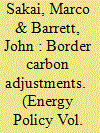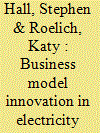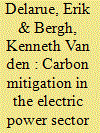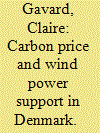|
|
|
Sort Order |
|
|
|
Items / Page
|
|
|
|
|
|
|
| Srl | Item |
| 1 |
ID:
150471


|
|
|
|
|
| Summary/Abstract |
Climate change is becoming an increasingly critical concern for human society. While there has been a great deal of research on climate change performance at the country/region level, our research focuses on the study of firm-level environmental efficiency as a proxy for firms' climate change management. Using a unique data set on U.S. S&P 500 firms for the period 2012–2013 and DEA slack-based models, we obtain firms' environmental efficiencies in six sectors. The results show significant performance dispersions both across and within the sectors. We highlight each sector's pros and cons in the environmental performance and propose guidelines for policy makers to further improve climate change performance. We also evaluate firms' operational performance and propose a unified performance measure by integrating operational and environmental efficiencies. Overall, we find there is no significant relationship between operational and environmental efficiencies in any of the six industrial sectors under study. The unified performance measures are more driven by the environmental efficiency than the operational efficiency.
|
|
|
|
|
|
|
|
|
|
|
|
|
|
|
|
| 2 |
ID:
150467


|
|
|
|
|
| Summary/Abstract |
This paper quantifies the CO2 emissions embodied in bi-lateral trade between Australia and China using a sectoral input–output model. The results revealed: (1) that China performs lower than Australia in clean technology in the primary, manufacturing, energy sectors due to their overuse of coal and inefficient sectoral production processes, and (2) that China had a 30.94 Mt surplus of bi-lateral CO2 emissions in 2010–2011 and (3) overall global emissions were reduced by 20.19 Mt through Australia–China trade in 2010–2011. The result indicates that the greater the energy efficient a country among the trading partners the lower will be the overall global CO2 emissions. Global emissions decreased mainly because China consumed Australian primary products rather than producing them. Australia is an energy efficient producer of primary products relative to China. The bilateral trade compositions and trade volume played an important role in lowering global emissions and therefore one can view proposed China Australia Free trade Agreement positively in reducing global emissions. However, for the sustainable development, China should strengthen clean energy use and both countries should adopt measures to create an emission trading scheme in order to avoid protectionism in the form of future border price adjustments.
|
|
|
|
|
|
|
|
|
|
|
|
|
|
|
|
| 3 |
ID:
150462


|
|
|
|
|
| Summary/Abstract |
Approximately one fourth of global emissions are embodied in international trade and a significant portion flows from non-carbon-priced to carbon-priced economies. Border carbon adjustments (BCAs) figure prominently as instruments to address concerns arising from unilateral climate policy. Estimating the volume of emissions that could be potentially taxed under a BCA scheme has received little attention until now. This paper examines how a number of issues involved in the implementation of BCAs can affect their ability to cover emissions embodied in trade and thus address carbon leakage. These issues range from ensuring compliance with trade provisions and assumptions on the carbon intensity of imports, to determining which countries are included and whether intermediate and final demand are considered. Here we show that the volume of CO2 captured by a scheme that involved all Annex B countries could be significantly reduced due to these issues, particularly by trade provisions, such as the principle of ‘best available technology’ (BAT). As a consequence, the tariff burdens faced by non-Annex B parties could dwindle considerably. These findings have important policy implications, as they question the effectiveness and practicalities of BCAs to reduce carbon leakage and alleviate competitiveness concerns, adding further arguments against their
|
|
|
|
|
|
|
|
|
|
|
|
|
|
|
|
| 4 |
ID:
150453


|
|
|
|
|
| Summary/Abstract |
Unconventional oil and gas development (UOGD) has recently become the subject of much research. However, neglected during this effort are the leases signed between landowner and industry that act as the foundation for development and may influence the distribution and intensity of associated impacts. These leases amount to an inscribed collection of rules and practices that define a wide variety of conditions related to development. The temporal and geographic distribution of lease terms may directly influence a number of phenomena of interest to scholars studying UOGD. In order to advance research on the subject, we (1) describe and outline research topics that could be addressed by applying social science methods to the analysis of leases and specific lease provisions, (2) discuss challenges and strategies for data collection and (3) review policy implications of lease related research.
|
|
|
|
|
|
|
|
|
|
|
|
|
|
|
|
| 5 |
ID:
150437


|
|
|
|
|
| Summary/Abstract |
This research investigates the new opportunities that business model innovations are creating in electricity supply markets at the sub-national scale. These local supply business models can offer significant benefits to the electricity system, but also generate economic, social, and environmental values that are not well accounted for in current policy or regulation. This paper uses the UK electricity supply market to investigate new business models which rely on more complex value propositions than the incumbent utility model. Nine archetypal local supply business models are identified and their value propositions, value capture methods, and barriers to market entry are analysed. This analysis defines 'complex value' as a key concept in understanding business model innovation in the energy sector. The process of complex value identification poses a challenge to energy researchers, commercial firms and policymakers in liberalised markets; to investigate the opportunities for system efficiency and diverse outcomes that new supplier business models can offer to the electricity system.
|
|
|
|
|
|
|
|
|
|
|
|
|
|
|
|
| 6 |
ID:
150458


|
|
|
|
|
| Summary/Abstract |
In Europe, CO2 emissions from the electric power sector and energy intensive industries are capped under a cap-and-trade system (i.e., the EU ETS). When other indirect measures are taken to impact emissions in a specific sector under the cap (such as a push for renewables in the electric power sector), this has implications on the overall allowance price, and on CO2 emissions both from this specific sector and the other sectors under the cap. The central contribution of this paper is the derivation of impact curves, which describe these interactions, i.e., the impact on allowance price and the shift of emissions across sectors. From a set of detailed simulations of the electric power system operation, a so-called “emission plane” is obtained, from which impact curves can be derived. Focus is on interactions between CO2 abatement through fuel switching and measures affecting the residual electricity demand (such as deployment of renewables) in the electric power sector, as well as on interactions with other sectors, both in a short-term framework. A case study for Central-Western Europe is presented. The analysis reveals a substantial impact of renewables on CO2 emissions, and hence on emissions shifts across sectors and/or on the CO2 price.
|
|
|
|
|
|
|
|
|
|
|
|
|
|
|
|
| 7 |
ID:
150443


|
|
|
|
|
| Summary/Abstract |
This paper aims at characterizing the conditions of wind power deployment in order to infer a carbon price level that would provide wind power with comparable advantage over fossil fuel technologies as effective wind support policies. The analysis is conducted on Denmark after the electricity market liberalization. Probit and tobit techniques are employed to take account of a potential threshold effect. I find that the level and type of the support policy are the dominant drivers of deployment. A feed-in tariff significantly brings more wind power in than a premium policy. The additional capacity installed monthly increases by more than 1 MW for each additional €/MWh of support. This is compared to the effect of the electricity price, investment cost, interest rate and general economic activity. If the policy is a premium, I find that 23€/MWh of support in addition to electricity price is needed to observe the connection of new turbines to the grid with a 0.5 probability. I convert this support level into a carbon price of 27€/ton if wind power competes with coal, and 48€/t if it competes with gas.
|
|
|
|
|
|
|
|
|
|
|
|
|
|
|
|
| 8 |
ID:
150457


|
|
|
|
|
| Summary/Abstract |
Research on household energy conservation often categorizes targeted behaviours by their behavioural attributes (e.g., savings, cost, frequency). The most common distinction in the literature divides behaviours as follows: (1) low-impact, low-cost, repetitive behaviours that result in a loss of comfort or curtailment behaviours and (2) high-impact, high-cost, infrequent behaviours that result in no loss of amenities or efficiency behaviours. However, such categorizations have often been ad hoc and two-dimensional (e.g., low-impact vs. high-impact, low-cost vs. high-cost). In contrast, we systematically assess a large range of household energy-saving behaviours (N=261) across nine attributes – energy savings, cost, frequency of performance, required skill level, observability, locus of decision, household function, home topography, and appliance topography. By clustering behaviours according to these attributes, we discern four clusters of energy-saving behaviours: family style, call an expert, household management and weekend project. We discuss the implications of these clusters for intervention design.
|
|
|
|
|
|
|
|
|
|
|
|
|
|
|
|
| 9 |
ID:
150470


|
|
|
|
|
| Summary/Abstract |
Given the problem of climate change, the world economy must eventually switch to carbon neutral energy. In this study we present a cost-effectiveness approach: given a goal of decarbonization, the objective is to accomplish this at minimum cost. For residential building energy, we show that total cost is minimized by equating marginal cost of building energy conserved with marginal cost of obtaining carbon-free energy, where we express costs of both in dollars per kWh. We describe how the cost of solar photovoltaic energy provides an upper bound on the marginal cost of carbon-free energy and thus an upper bound on marginal cost of conserved energy—one should not necessarily spend more on energy conservation than the cost of photovoltaic energy (though there are several caveats). A case study from Vermont, USA illustrates these principles and implementation issues with marginal analysis of energy conservation. From a policy perspective, the principles presented suggest that either carbon taxes or carbon limits could be used to decarbonize building energy at minimum cost, but that approaches using renewable-energy subsidies or prescriptive building codes result in greater decarbonization costs to society. This suggests that new policy approaches be adopted.
|
|
|
|
|
|
|
|
|
|
|
|
|
|
|
|
| 10 |
ID:
150469


|
|
|
|
|
| Summary/Abstract |
Uncovering the driving factors of CO2 emission intensity declining is important for China. This paper improves the logarithmic mean Divisia index technique, which includes energy density and energy consumption intensity, to explore the driving factors of carbon emission intensity (CI) in 29 Chinese provinces from 1995–2012. The main results are: (1) energy consumption intensity plays a more important role than carbon emission density (CD) for a rapid decrease in CI during the research period, so a much room is left for a significant CD reduction through carbon emission reduction technology, energy structural reduction, and energy consumption proportional reduction. (2) The decrease in energy consumption technology and energy structure in secondary industries contributes the most reduction in energy consumption intensity. (3)The energy consumption proportions of secondary and tertiary industries are the two most important drivers to decrease CD. (4) During the research period, the energy consumption proportions of secondary industries result in the most decrease in CD, whereas the energy consumption proportions of tertiary industries cause the most increase in CD.
|
|
|
|
|
|
|
|
|
|
|
|
|
|
|
|
| 11 |
ID:
150449


|
|
|
|
|
| Summary/Abstract |
The Department of Defense (DOD) is the major consumer of energy within the Federal government, and it has been directed to implement cost cutting measures related to energy dependence through numerous Executive Orders and Congressional legislation. As a result, the DOD released an Energy Strategy which outlines ways to reduce energy requirements in order to meet both Presidential and Congressional mandates for energy security. With this research, we provide a historical review (1973–2014) of energy policy, legislation, and research. Additionally we identify gaps between strategy and research. The results show that DOD energy research lacks a unifying structure and guiding framework. We propose a knowledge management framework to unify and guide research efforts in direct support of the DOD Energy Strategy.
|
|
|
|
|
|
|
|
|
|
|
|
|
|
|
|
| 12 |
ID:
150430


|
|
|
|
|
| Summary/Abstract |
Does a trade-off exist between energy efficiency and economic growth? This question underlies some of the tensions between economic and environmental policies, especially in developing countries that often need to expand their industrial base to grow. This paper contributes to the debate by analyzing the relationship between energy efficiency and economic performance at the micro- (total factor productivity) and macro-level (countries' economic growth). It uses data on a large sample of manufacturing firms across 29 developing countries to find that lower levels of energy intensity are associated with higher total factor productivity for the majority of these countries. The results are robust to a variety of checks. Suggestive cross-country evidence points towards the same relation measured at the macro-level as well.
|
|
|
|
|
|
|
|
|
|
|
|
|
|
|
|
| 13 |
ID:
150473


|
|
|
|
|
| Summary/Abstract |
The gradual trend towards the electrification of economies has raised new challenges. Focusing on France, this paper uses monthly data from January 2010 to November 2014, to study the challenge of the simultaneous integration of various sources of generation, and their relationship with economic growth. For the analysis of the dynamics of interaction between electricity sources, the auto-regressive distributed lag (ARDL) bounds test approach was shown to be appropriate, as it allows short- and long-run effects to be distinguished. The results showed that nuclear energy has been a huge driver of economic growth in France and, at the same time, leads to an environment with lower CO2 emissions. Renewables were shown to exert a negative effect on economic growth, which could be due to lack of investment in other sources of production, due to the resilient position held by nuclear sources. The substitution effect among sources is noticeable. The robustness of the results was checked using annual data, from 1970 until 2012, and the results were comparable to those from the monthly data.
|
|
|
|
|
|
|
|
|
|
|
|
|
|
|
|
| 14 |
ID:
150472


|
|
|
|
|
| Summary/Abstract |
This paper focuses on demonstrating the feedback relationships between greenhouse gas emissions efficiency in the electricity sector and employment reallocation with a consideration of the effects of electricity restructuring and socio-demographic factors. We postulate the construction, information, manufacturing, utilities, and mining sectors as a group of emissions efficiency-related industries and identify the mutual relationships. The emissions efficiency positively influences the job shares of these industries except mining, whereas increased employment in these industries has a negative effect on the emissions efficiency. Electricity restructuring has a positive effect on overall employment, however, it does not have a statistically significant effect on the emissions efficiency. Additionally, population aging and educational attainment have positive effects on the emissions efficiency, and a higher proportion of rental households has a negative influence on it. Increases in renewable energy and nuclear energy generation have elastic effects on enhancing emissions efficiency.
|
|
|
|
|
|
|
|
|
|
|
|
|
|
|
|
| 15 |
ID:
150446


|
|
|
|
|
| Summary/Abstract |
This paper investigates the effect of Energy Performance Certificate (EPC) ratings on residential prices in Wales. Drawing on a sample of approximately 192,000 transactions, the capitalisation of energy efficiency ratings into house prices is investigated using two approaches. The first adopts a cross-sectional framework to investigate the effect of EPC rating on price. The second approach applies a repeat-sales methodology to investigate the impact of EPC rating on house price appreciation. Statistically significant positive price premiums are estimated for dwellings in EPC bands A/B (12.8%) and C (3.5%) compared to houses in band D. For dwellings in band E (−3.6%) and F (−6.5%) there are statistically significant discounts. Such effects may not be the result of energy performance alone. In addition to energy cost differences, the price effect may be due to additional benefits of energy efficient features. An analysis of the private rental segment reveals that, in contrast to the general market, low-EPC rated dwellings were not traded at a significant discount. This suggests different implicit prices of potential energy savings for landlords and owner-occupiers.
|
|
|
|
|
|
|
|
|
|
|
|
|
|
|
|
| 16 |
ID:
150432


|
|
|
|
|
| Summary/Abstract |
Road transport is one of the sectors with highest energy consumptions in the planet, with large dependence of fossil fuels, and contribution for global greenhouse gas emissions. Although, Latin America is not a high-energy consumer, its share in global consumption is expected to grow, especially in the transportation sector. This make essential for developing countries the adoption of better policies to identify the vehicle groups with largest fuel demands. The present study describes the VKT technique to disaggregate road transport energy consumption by vehicle type, applied to the road transportation system of Ecuador. It also describes the procedures performed to estimate the variables required to run the model, and some of the practical applications that be used to create public policies. Results show as the biggest fuel consumers the heavy-duty freight cargo, followed by light duty vehicles. The estimation of greenhouse gas emissions evidence that road transport released 14.3 million tons of CO2 in 2012. When fuel consumption is compared by it costs, it can be confirmed that Ecuadorean Government covered, through subsidies, for 68% of the annual fuel costs of national road transport, demonstrating the importance of restructuring these expenditures in order to achieve an efficient road transport system.
|
|
|
|
|
|
|
|
|
|
|
|
|
|
|
|
| 17 |
ID:
150439


|
|
|
|
|
| Summary/Abstract |
Designing a desirable increasing block tariff for the residential gas retail market has been a challenging task for regulated utilities, especially in China. To deal with such problems, in this paper, we establish an agent-based, computational economics system to provide a formal evaluation of the direct and indirect influences of several issued increasing block tariffs in the residential gas market. Moreover, a comprehensive demand response behaviour model has been improved in term of price elasticity, while still coping with income levels and complex social environment. We also compute and compare the outcomes of several increasing block tariffs with the initial flat tariff by running the system on a test-case using real-world data from a middle-scale gas retail market in Wuhan. The results indicate that there is an appropriate increasing block gas tariff scheme that has greater ability to improve social equity while still ensuring operator revenue and promoting gas conservation. In order to offset the limitations of the proposed increasing block tariffs, the regulator should adopt some complementary measures, such as applying appropriate policies targeting the intended consumers, and allowing large families to obtain extra allowance of volume.
|
|
|
|
|
|
|
|
|
|
|
|
|
|
|
|
| 18 |
ID:
150431


|
|
|
|
|
| Summary/Abstract |
The after-market roof rack is one of the most common components attached to a vehicle for carrying over-sized items, such as bicycles and skis. It is important to understand these racks’ fuel consumption impacts on both individual vehicles and the national fleet because they are widely used. We estimate the national fuel consumption impacts of roof racks using a bottom-up approach. Our model incorporates real-world data and vehicle stock information to enable assessing fuel consumption impacts for several categories of vehicles, rack configurations, and usage conditions. In addition, the model draws on two new data-gathering techniques, on-line forums and crowd-sourcing. The results show that nationwide, roof racks are responsible for 0.8‰ of light duty vehicle fuel consumption in 2015, corresponding to 100 million gallons of gasoline per year. Sensitivity analyses show that results are most sensitive to the fraction of vehicles with installed roof racks but carrying no equipment. The aerodynamic efficiency of typical roof racks can be greatly improved and reduce individual vehicle fuel consumption; however, government policies to minimize extensive driving with empty racks—if successful—could save more fuel nationally.
|
|
|
|
|
|
|
|
|
|
|
|
|
|
|
|
| 19 |
ID:
150434


|
|
|
|
|
| Summary/Abstract |
Ghana's electricity generation capacity is currently insufficient to meet demand, making power outages and load shedding common. The resulting impact is potentially devastating for the country's growth prospects. Traditionally, lack of an affordable and reliable fuel supply for power generation, coupled with ineffective institutions and an unfavourable investment climate, have resulted in Ghana's electricity sector performing poorly. In light of the 2007 discovery of natural gas reserves in Ghanaian waters, this paper examines whether domestic gas could advance the performance of the electricity sector, and if so, how. The results of our analysis show that utilization of gas reserves in Ghana's gas-to-power market is an economically superior strategy compared to an export-oriented utilization scheme. The lack of an effective regulatory framework for investment, skill shortages, and an inefficient electricity pricing structure continue to be the main constraining factors. Our analysis also considers possible approaches to modification of the electricity tariff in order to send the right signal to potential investors in generation capacity, without compromising the affordability of power supply.
|
|
|
|
|
|
|
|
|
|
|
|
|
|
|
|
| 20 |
ID:
150476


|
|
|
|
|
| Summary/Abstract |
The aim of this research paper is to investigate factors and mechanisms that may facilitate the transition from coal resource-based economy to sustainability. Based on the energy technology innovation theory, factors that may influence the transition of coal resource-based economy were categorized into four types, including: innovation policy, innovation input, innovation ability, and innovation organization. Hypotheses were proposed regarding the mechanisms of these factors. Data were collected from surveys administered to 314 Chinese energy firms, and a structural equation model (SEM) was employed to test the hypotheses. Ten of fifteen hypotheses were retained based on the reliability tests, validity tests, and SEM. The results show that the four proposed factors are crucial in transforming the coal resource-based economy, and the effects become statistically significant through three intermediate variables, namely, transition of energy consumption structure, correction of resource wealth investment, and improvement of transition environment.
|
|
|
|
|
|
|
|
|
|
|
|
|
|
|
|
|
|
|
|
|